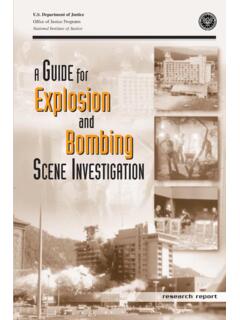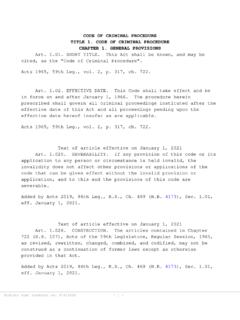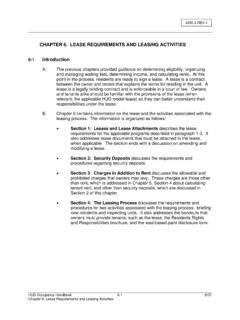Transcription of Urban Street Gang Enforcement - Office of Justice Programs
1 Department of JusticeOffice of Justice ProgramsBureau of Justice AssistanceUrban Street GangEnforcementMonographBureau of Justice AssistanceThis document was prepared by the Institute for Law and Justice , Inc., supported by grantnumber 92 DD CX 0014, awarded by the Bureau of Justice Assistance, Office of JusticePrograms, Department of Justice . The opinions, findings, and conclusions or recom-mendations expressed in this document are those of the authors and do not necessarilyrepresent the official position or policies of the tment of Department of JusticeOffice of Justice Programs810 Seventh Street , DC 20531 Janet RenoAttorney GeneralRaymond C.
2 FisherAssociate Attorney GeneralLaurie RobinsonAssistant Attorney GeneralNo l BrennanDeputy Assistant Attorney GeneralNancy E. GistDirector, Bureau of Justice AssistanceOffice of Justice ProgramsWorld Wide Web Home of Justice AssistanceWorld Wide Web Home grant and funding information Department of Justice Response Center1 800 421 6770 The Bureau of Justice Assistance is a component of the Office of Justice Programs , which alsoincludes the Bureau of Justice Statistics, the National Institute of Justice , the Office of JuvenileJustice and Delinquency Prevention, and the Office for Victims of Street Gang EnforcementBureau of Justice AssistanceUrban Street GangEnforcementMonographJanuary 1997 Reprinted August 1999 NCJ 161845iiiUrban Street Gang EnforcementForewordGangs have been a major contributor to the growth of violent crime in thepast decade.
3 Heavily armed with sophisticated weapons, gangs are in-volved in drug trafficking, murder, witness intimidation, robbery, extor-tion, and turf battles. Gangs now operate in cities of all sizes, as well assuburban communities throughout the United States; gang violence nolonger is limited to major is being done to stop gang activity? Federal, State, and local law en-forcement agencies across the country have implemented innovative andresourceful initiatives to stop gangs from terrorizing our and multijurisdictional efforts range from special unitsdedicated to investigating and prosecuting gang-related crimes to state-of-the-art surveillance equipment and sophisticated data collection andanalysis purpose in developing Model Strategies for Urban Street Gang En-forcement was to create processes and strategies that would be useful inmany jurisdictions.
4 No one method will solve the gang problem; however,some methods are more effective and better suited to certain monograph presents strategies to enhance prosecution of gang-related crimes. It focuses exclusively on Enforcement and prosecutionstrategies against Urban Street gangs. The model Programs introducedhere offer strategies largely based on the practical experiences of agenciesthat participated in a demonstration program funded by the Bureau of Jus-tice Assistance (BJA) and designed to establish model approaches to pre-vent and suppress gang monograph offers a step-by-step guide for designing and implement-ing a program based on Model Strategies for Urban Street Gang Enforce-ment.
5 It identifies and explores innovative methods of prosecuting gangmembers involved in criminal activities. Program examples and case stud-ies from the seven demonstration sites illustrate how local objectives weremet. By documenting and disseminating effective strategies to combatgang violence, BJA hopes to assist law Enforcement E. GistDirectorvUrban Street Gang EnforcementAcknowledgmentsThe Bureau of Justice Assistance (BJA) wishes to thank the Institute forLaw and Justice (ILJ) staff for their efforts in writing this monograph. Spe-cifically, Edward Connors, Barbara Webster, Neal Miller, Claire Johnson,and Elizabeth Fraser were responsible for the project research and docu-ment preparation.
6 Bill Falcon conducted research and drafted several sec-tions, and Diana Saenz and Peter Ohlhausen performed research andprovided editorial support in preparing the draft. Luke Galant was the BJAP rogram Manager responsible for oversight of this Street Gang EnforcementContentsExecutive Summary .. xiiiChapter 1 Introduction .. 1 Focus on Law Enforcement .. 1 Urban Street Gang Program .. 2 Gang Problems Addressed by This Prototype .. 3 Varying Levels of Law Enforcement Resources .. 4 Chapter 2 Key Elements of the Gang Suppression Prototype .. 7 Planning and Analysis .. 7 Gang Information and Intelligence Systems.
7 8 Gang Suppression Strategies and Tactics .. 8 Interagency Cooperation and Collaboration .. 9 Legal Issues .. 10 Evaluation .. 10 Chapter 3 Planning and Analysis .. 13 The Need for Common Definitions .. 13 Analysis .. 14 Types of Analysis .. 14 Levels of Analysis .. 15 Assessment of criminal Gang Activity .. 16 The Nature and Extent of the Gang Problem .. 16 Gang Patterns and Trends .. 17 The Environment .. 18 The Jurisdiction as a Whole .. 18 Targeted Neighborhoods .. 19 Information Sources .. 20 Inventory of Resources .. 21 Implementation and Management Plan .. 23 Department Organizational Issues.
8 23 Goals, Objectives, and Strategies .. 24 Communication and Publicity .. 24 Training .. 25 Evaluation .. 25 Chapter 4 Gang Information and Intelligence Systems .. 27 Importance of the Gang Database .. 27 Overcoming Denial .. 27 Targeting Gangs .. 27 Selecting Suppression Strategies and Tactics .. 28 Increasing Officer Safety .. 28viiiBureau of Justice Assistance Tracking Gang Mobility .. 28 Determining Content of the Gang Database .. 29 How Gang-Related Definitions Affect Database Content .. 30 Gang-Related Crime VersusGang-Motivated Crime .. 30 Gang Members Versus Gang Wannabes.
9 31 Data Elements for Intelligence and Management .. 34 Strategic, Tactical, and Managerial Information Needs .. 35 Legal Requirements .. 35 Manual Versus Automated Systems .. 37 Database Information Sources .. 37 Patrol Officers .. 37 Gang Specialists .. 38 Confidential Informants .. 39 Other criminal Justice Agencies .. 41 Community Organizations and Agencies .. 42 Outside Databases .. 43 Regional Information Sharing Systems .. 43 The Bureau of Alcohol, Tobacco and Firearms .. 44 Gang Reporting, Evaluation, and Tracking .. 44 Regional Databases .. 44 Disseminating Gang Information.
10 46 Within the Agency .. 46 To Other criminal Justice Agencies .. 47 Chapter 5 Gang Suppression Operations and Tactics .. 49 Developing Strategies Based on Gang Intelligence .. 49 Street Gang Classifications and Characteristics .. 50 Asian Street Gangs .. 50 Hispanic Gangs .. 51 Crips and Bloods .. 52 Jamaican Posses .. 52 Chicago Gangs .. 53 Other Street Gangs .. 53 Other criminal Gangs .. 54 Implications of Gang Characteristics for Law Enforcement Strategies .. 54 Language and Cultural Barriers .. 54 Control of Geographic Areas .. 57 Insulation of Adult Leaders .. 58 Contents (continued)ixUrban Street Gang EnforcementKnowledge of Police Operations and Policies.


















